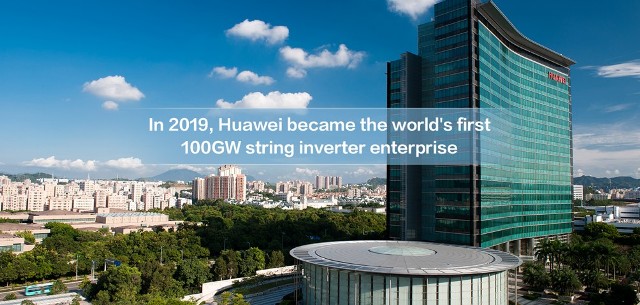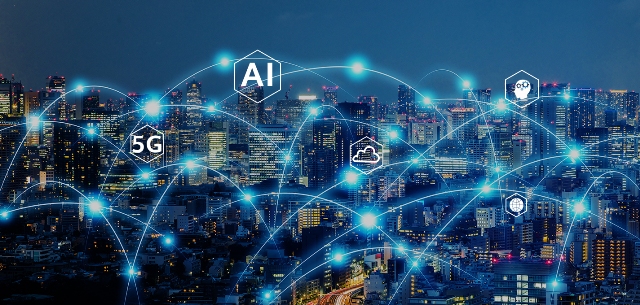The First String Inverter Brand with Over 100GW Deployment Globally II 10 years of Huawei Smart PV journey
Introduction: Within the PV industry, it is widely believed that SMA invented string inverters while Huawei make them thrived.
Pushing the Boundary
In 2015, the PV Forerunner Project led by the National Energy Administration was initiated. Huawei Smart PV Solution had achieved great success, and Huawei string inverters accounted for over 50% of the total. In the 2016 Forerunner Project, Huawei smart string inverters accounted for over 65% of the total.
Huawei Smart PV Solution developed at a rapid pace, with a major version releasing every year. As the PV industry enters the digital era and wireless communication becoming increasingly secure, power grids becomes more open and inclusive. Following the application of the Smart PV Wireless Broadband System in a Baofeng PV plant project in Ningxia, the duty chief said, “the traditional PV plant communication mode was unable to meet our mobile requirements, which restricted the development of the PV plants. Once the wireless system is used, a 4G base station can be deployed in a PV plant to implement intra-plant communication, simplifying construction and O&M. Wireless communications have the capacity to solve complex and diverse PV plant problems.”
In addition to propelling the Chinese market into the intelligent era, Huawei also became a trendsetter in the foreign market.
Recently Huawei released a video about its products limit tests. In addition to simulating such adverse weather as typhoons and extreme cold, Huawei also conducted costly explosion and outdoor lightning tests.
Such in-depth testing stunned customers outside China and make them trusting the quality of Huawei products. Energy giants in Europe and Japan turned to Huawei for cooperation, which enabled them to quickly and successfully become leaders in their respective markets. In areas featuring strict requirements on power grids, such as Europe, Japan, and Australia, power grid adaptability is a challenge which places high requirements on inverter providers. Despite such challenges, Huawei meets the requirements of local power grids and becomes the brand of choice in these markets.
O&M is also a significant challenge for inverters globally, as the manpower cost outside China is higher and central inverters require professionals to handle faults onsite. Even within China, this process can take up to one week. However, Huawei inverters are maintenance-free, almost eliminating the need for O&M personnel to be present onsite. In case of breakdown, the faulty device can be replaced quite quickly, which takes approximately 2 hours.
Owing to a wealth of experience and a strong focus on products, Huawei is among the best in the world's major high-end markets.
From that year in 2015, global shipments of Huawei inverters are ranked No. 1 in the IHS Markit ranking.
Even at the top, Huawei still faces many challenges and ever-increasing customer requirements.
Is it possible to maximize the power generation capacity of each string of PV modules?
Previously, the inspection of PV modules at a PV plant was performed by workers using EL and I-V detection tools. For utility PV plants, the inspection was usually performed after faults were located or during a PV plant spot check. A 100MW power plant has 300,000 PV modules, nearly 20,000 PV strings, covering an area of more than two square kilometers. If a comprehensive inspection needs to be manually performed, O&M personnel must travel hundreds of kilometers by foot and individually test each PV module. The onsite terminal removal test is also a potentially dangerous procedure and may lead to energy yield loss. As such, a comprehensive inspection is an almost impossible task.
As the management of the PV plant continues to develop and PV plant transaction volumes gradually increase, owners and investors are eager to gain additional insights into the PV plant status. In this regard, Huawei again takes the lead in solving the problem by providing a solution, in simple terms: grade the PV plant performance.
The Huawei technical team quickly considered the I-V curve test function and successfully applied it to inverters. In 2014, Huawei took the lead in joint R&D with Huanghe Hydropower Development Co., Ltd and conducted a large number of tests.
By testing the I-V curve of PV modules through reverse power supply, this Smart I-V Curve Diagnosis technology can identify 14 common failures, including hidden PV module cracks, hot spots, backplane failures, and diode damage.
Following three upgrade versions, Huawei Smart I-V Curve Diagnosis has now applied for over 5 GW PV plants worldwide, and the number of detected PV modules exceeds 10 million. In addition to this widespread application, the AI-based Smart I-V Curve Diagnosis 4.0 further improves detection speeds, requiring just 15 minutes to completely scan an entire 100 MW PV plant. Bifacial, shingled, and hybrid mixed PV modules are all supported. While most industry vendors jumped on this trend almost overnight, the required technology is based on massive data accumulation. Without such big data and an advanced algorithm, detection accuracy cannot be ensured.

The Smart I-V Curve Diagnosis is the decisive factor contributing to the Smart PV industry intelligence, and only string inverters can provide such analysis. At the same time, the accuracy of Smart I-V Curve Diagnosis also provides an effective defense for Huawei technology and prevents missing or false reports. As Huawei Smart I-V Curve Diagnosis is based on the analysis of massive data reported from over 100 GW smart devices.
Smart I-V Curve Diagnosis for more than 5 GW PV modules not only ensures energy yields, but also obtains precious big data during the process. For example, backplanes have been a controversial topic within the industry, and big data confirms that the damage rate of PV module diodes in China western regions is much higher than that in the east. The cause of such a higher rate of damage relates to the increased strength of ultraviolet rays in western regions. If the backplanes are too thin or unsuitable materials are used, the failure rate of the diodes will be significantly higher than that in the east. As such, backplanes delivered to China western regions should be strengthened to cope with the harsher environments they will face.
In addition, Huawei has developed the optimal "bifacial PV module + tracking system" matching mode based on big data. The traditional "astronomical algorithm + anti-tracking" mode combines the GPS calibration time to obtain the absolute position of the sun, and the corresponding tracking angle can be obtained by minimizing the angle between the PV module and the incident light of the sun. This traditional algorithm considers only the direct radiation at the front of PV modules when the scattering ratio is low. In some scenarios, the traditional algorithm may fail to obtain the optimal angle, leading to energy yield loss. For example, on cloudy days, an angle calculated by an astronomical algorithm is not the optimal angle. Huawei's smart tracking system detects external factors such as radiation, temperature, and wind speed, and uses precise big data and AI learning algorithms to obtain the optimal rotation angle of the tracking supports in real time. In this way, the functions of bifacial PV modules are fully utilized, ensuring the optimal energy yield of the PV plant.
To date, AI has achieved cross-industry collaboration and completed the last step of "massive scenarios + expert experience + cross-domain convergence", greatly unleashing the potential of PV plants.
In 2019, Huawei became the first string inverter brand with 100 GW deployment globally. A decade hard work from Huawei created a miracle in the in the industry.

Intelligence Enables a Brighter Future
In many PV plants outside China, 200 MW or even 500 MW PV plant, only a 20-people O&M team is required.
While such an O&M arrangement would have previously been impossible, Huawei Smart PV Solution has made it a reality.
In 2019, France Telecom cooperated with Abu Dhabi Future Energy Company (MASDAR) in a Sakaka 300 MW PV project, within which Huawei Smart PV Solution was deployed. The local price of electricity was only 2.34 cents/kWh, even lower than the price of hydropower in China, which stunned the industry at the time.
While the LCOE and O&M problems of PV plants have been resolved, Huawei has now been entrusted with new challenges as we enter the next stage.
PV is not the only business they focus on for international energy groups such as EDN in France and Enel in Italy. As such, how to better integrate solar with their existing energy business is a question of vital importance.
Initially having chosen Huawei for a high level of service continuity, these international energy groups later discovered that only Huawei can provide a matching support platform for their entire energy business. As 5G and AI technologies continue to develop rapidly, these international giants remain consistent in their choice.
Large and complex entities require partners in a similar level. While the future direction is rather clear, the way to get there remains challenging. In this high-stake market, having the right partner is essential.
International energy groups usually work with multiple forms of energy across various business scopes. As a result, they must consider not only the LCOE for new energy but also the stability and comprehensive utilization of the power grid. These companies are also proactive in promoting smart power meters and energy storage systems, consolidating the development of new business forms with digital power grids, coordinating electricity sources, grids, loads, and storage, integrating multiple sites, and improving the efficiency of comprehensive energy utilization.
In collaboration with Huawei, they have begun work on the next generation of energy structures. "Many of these studies are targeting at technologies for the next five or even ten years, and may introduce profound changes to the industry in the near future," said Huawei's Smart PV head of R&D. "Multi-domain collaboration is also moving from the PV industry to the energy internet."
The new-generation AI powered PV plants reflect the safety, stability, cleanliness, and cost-effectiveness of new energy. However, the question of how new energy becomes the main source of high-quality energy is now the burning issue. Huawei innovatively applies an AI self-learning algorithm for impedance reshaping. This algorithm integrates multiple other advanced algorithms, such as the adaptive algorithm for dynamic damping, the self-adaptive algorithm for intelligent series compensation, and the active harmonic suppression algorithm. The electrical characteristics of a PV plant are dynamically adjusted to the power grid via AI self-learning, ensuring stable operations and a continuous connection. This capability indicates the PV plant's shift in status from a passive grid adapter to an active grid supporter.
Yet AI is capable of much more.

The development of new energy has kicked off a game-changing energy revolution, greatly exceeding the expectations of the industry. However, an energy system with renewable energy as the core, the construction of an energy IoT, and the fully connected world of the future have not yet been fully realized, and a great deal of challenges await. When the complexity of all these exceeds human’s limit, Al steps in as the energy nerve center and connecting all the dots.
Huawei's commitment to a better today lays the foundation for a brighter tomorrow.

